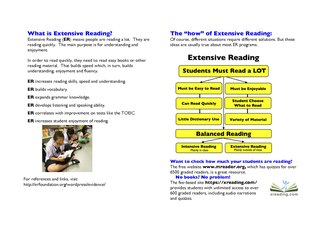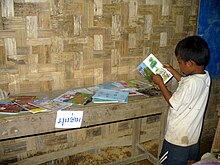
Literacy in its broadest sense describes "particular ways of thinking about and doing reading and writing" with the purpose of understanding or expressing thoughts or ideas in written form in some specific context of use. In other words, humans in literate societies have sets of practices for producing and consuming writing, and they also have beliefs about these practices. Reading, in this view, is always reading something for some purpose; writing is always writing something for someone for some particular ends. Beliefs about reading and writing and its value for society and for the individual always influence the ways literacy is taught, learned, and practiced over the lifespan.

Whole language is a philosophy of reading and a discredited educational method originally developed for teaching literacy in English to young children. The method became a major model for education in the United States, Canada, New Zealand, and Great Britain in the 1980s and 1990s, despite there being no scientific support for the method's effectiveness. It is based on the premise that learning to read English comes naturally to humans, especially young children, in the same way that learning to speak develops naturally.

Phonics is a method for teaching people how to read and write an alphabetic language. It is done by demonstrating the relationship between the sounds of the spoken language (phonemes), and the letters or groups of letters (graphemes) or syllables of the written language. In English, this is also known as the alphabetic principle or the Alphabetic code.

In literary criticism, close reading is the careful, sustained interpretation of a brief passage of a text. A close reading emphasizes the single and the particular over the general, effected by close attention to individual words, the syntax, the order in which the sentences unfold ideas, as well as formal structures. A truly attentive close reading means thinking about both what is being said in a passage, and how it is being said and leading it to possibilities for observation and insight.

Readability is the ease with which a reader can understand a written text. In natural language, the readability of text depends on its content and its presentation. Researchers have used various factors to measure readability, such as:
The Center for the Book was founded in 1977 by Daniel J. Boorstin, the Librarian of Congress, to promote literacy, libraries, and reading and an understanding of the history and heritage of American literature. The Center for the Book is mainly supported by tax-deductible donations. In 1984, the Center began creating affiliated State Centers for the Book. Today, the Center for the Book has an affiliate Center in all 50 States, the District of Columbia, and in the U.S. Virgin Islands.

Functional illiteracy consists of reading and writing skills that are inadequate "to manage daily living and employment tasks that require reading skills beyond a basic level". People who can read and write only in a language other than the predominant language of where they live may also be considered functionally illiterate. Functional illiteracy is contrasted with illiteracy in the strict sense, meaning the inability to read or write simple sentences in any language.

Sustained silent reading (SSR) is a form of school-based recreational reading, or free voluntary reading, where students read silently in a designated period every day, with the underlying assumption being that students learn to read by reading constantly. While classroom implementation of SSR is fairly widespread, some detractors note that the data showcasing SSR’s effectiveness is shaky at best and that SSR alone does not craft proficient readers. Despite this, many maintain that successful models of SSR typically allow students to select their own books and do not require testing for comprehension or book reports. Schools have implemented SSR under a variety of names, such as "Drop Everything and Read (DEAR)", "Free Uninterrupted Reading (FUR)", or "Uninterrupted sustained silent reading (USSR)".

Reading comprehension is the ability to process text, understand its meaning, and to integrate with what the reader already knows. Fundamental skills required in efficient reading comprehension are knowing meaning of words, ability to understand meaning of a word from discourse context, ability to follow organization of passage and to identify antecedents and references in it, ability to draw inferences from a passage about its contents, ability to identify the main thought of a passage, ability to answer questions answered in a passage, ability to recognize the literary devices or propositional structures used in a passage and determine its tone, to understand the situational mood conveyed for assertions, questioning, commanding, refraining etc. and finally ability to determine writer's purpose, intent and point of view, and draw inferences about the writer (discourse-semantics).
Accelerated Reader (AR) is a website used to assist students with reading skills.
Adolescent literacy refers to the ability of adolescents to read and write. Adolescence is a period of rapid psychological and neurological development, during which children develop morally, cognitively, and socially. All of these three types of development have influence—to varying degrees—on the development of literacy skills.
Shared reading is an instructional approach in which the teacher explicitly models the strategies and skills of proficient readers.

High frequency sight words are commonly used words that young children are encouraged to memorize as a whole by sight, so that they can automatically recognize these words in print without having to use any strategies to decode. Sight words were introduced after whole language fell out of favor with the education establishment.
Balanced literacy is a theory of teaching reading and writing that arose in the 1990s and has a variety of interpretations. For some, balanced literacy strikes a balance between whole language and phonics and puts an end to the so called reading wars. Others say balanced literacy in practice usually means the whole language approach to reading.

Extensive Reading (ER) is the process of reading longer easier texts for an extended period of time without a breakdown of comprehension, feeling overwhelmed, or the need to take breaks. It stands in contrast to intensive or academic reading, which is focused on a close reading of dense shorter texts, typically not read for pleasure. Though used as a teaching strategy to promote second-language development, ER also applies to free voluntary reading and recreational reading both in and out of the classroom. ER is based on the assumption that we learn to read by reading.

The Lexile Framework for Reading is an educational tool that uses a measure called a Lexile to match readers with books, articles and other leveled reading resources. Readers and books are assigned a score on the Lexile scale, in which lower scores reflect easier readability for books and lower reading ability for readers. The Lexile framework uses quantitative methods, based on individual words and sentence lengths, rather than qualitative analysis of content to produce scores. Accordingly, the scores for texts do not reflect factors such as multiple levels of meaning or maturity of themes. Hence, the United States Common Core State Standards recommend the use of alternative, qualitative methods for selecting books for students at grade 6 and over. In the US, Lexile measures are reported from reading programs and assessments annually. Thus, about half of U.S. students in grades 3rd through 12th receive a Lexile measure each year. In addition to being used in schools in all 50 states, Lexile measures are also used outside of the United States.
The National Book Trust of Uganda (NABOTU), founded in 1997, is a non-government organization that brings together associations and institutions within Uganda’s book sector to promote authorship, publishing and a culture of reading in Uganda.
Pam Allyn is an American literacy expert and author. She is the Senior Vice-president for Innovation at Scholastic Education. She is the founder of LitWorld, a global literacy initiative serving children across the United States and in more than 60 countries. She is also the founder of LitLife, a consulting group working with schools to enrich best practice teaching methods and building curriculum for reading and writing. She is the author of the Your Child's Writing Life, Pam Allyn's Best Books for Boys: How To Engage Boys in Reading in Ways That Will Change Their Lives (Scholastic), What To Read When: The Books and Stories To Read With Your Child–And All The Best Times To Read Them, and Core Ready, a 14-book series focusing on the Common Core Learning Standards (Pearson). Allyn is widely known as a motivational speaker advocating for reading and writing as human rights that belong to all people. Her personal quest to bring literacy to every child stems from a deeper desire to bring dignity to every child, and to empower children to read and write powerfully, effectively and with passion in ways that will change their worlds and the worlds of others. Her work has been featured on Good Morning America, The Today Show, Oprah Radio, The Huffington Post, CNN International, and in The New York Times. Allyn is the Global Ambassador for Scholastic's "Read Every Day. Lead a Better Life." Campaign. She is also a spokesperson for BIC Kids, championing BIC's 2014 "Fight For Your Write" campaign.

The Bluford Series is a widely read collection of contemporary American young adult novels set in the fictional inner-city high school of Bluford High in Southern California. Bluford is named for Guion "Guy" Bluford, the first African-American astronaut. The series was created and published by Townsend Press and was co-distributed by Scholastic. As part of an effort to promote reading in underfunded school districts, Townsend Press originally made the Bluford Series available to schools for a dollar each. As of 2018, over 11 million Bluford Series novels were in print.

The World Literacy Foundation(WLF) is a global not-for-profit that works to lift young people out of poverty through literacy. Founded in Melbourne, Australia in 2003, the World Literacy Foundation operates on the principle that education is a basic human right. It aims to eradicate global illiteracy through the promotion of literacy and the provision of educational resources.





